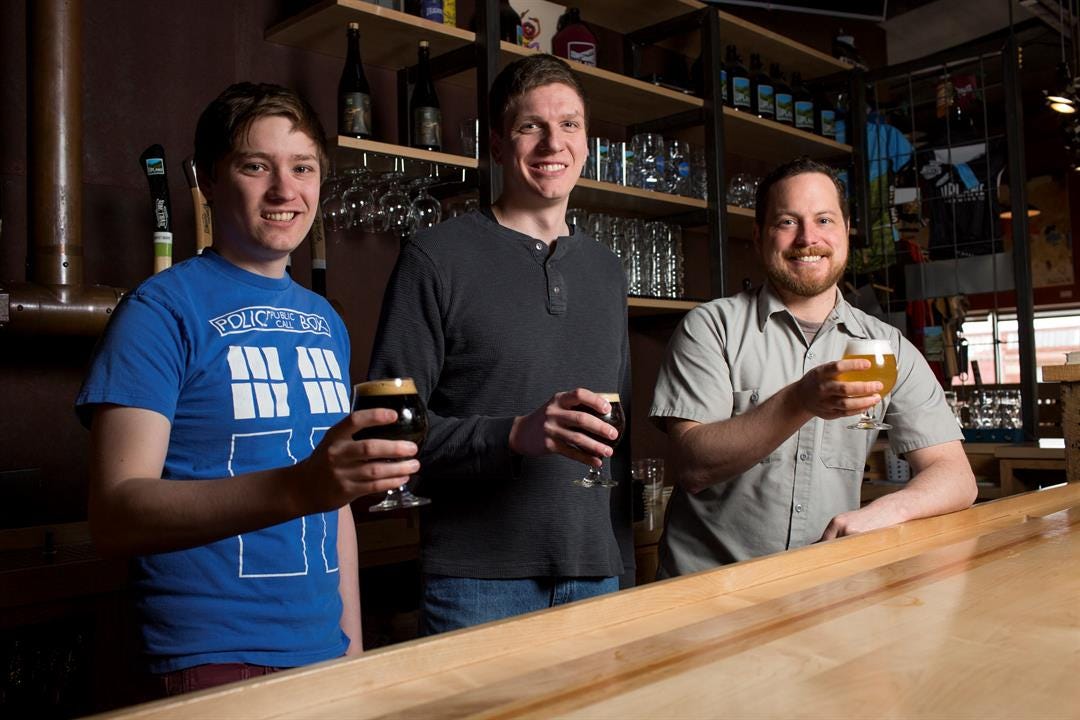Scientist Solves a ‘Sour’ Note at Upland Brewing
 IU graduate student Cody Rogers (left)
IU graduate student Cody Rogers (left)
Subscriber Benefit
As a subscriber you can listen to articles at work, in the car, or while you work out. Subscribe NowBloomington-based Upland Brewing Co. is raising a glass to an Indiana University scientist who recently solved a mystery brewing within its bottles. It had to dump some 1,600 gallons of beer—worth about $22,000—after a special fermentation method failed twice. Aptly named Cauldron, the beer was bewitched by yeast that refused to cooperate, until the IU biochemist was able to undo the hex in his laboratory, creating a solution for Upland—and any brewery stumped by the scientific nuances of yeast.
Cauldron is a traditional sour beer, one of the fastest growing segments in the craft beer industry and a style the brewery has been making for about a decade. That’s why Upland President Doug Dayhoff says “we were really stumped” when even the brewery’s two in-house microbiologists couldn’t decode why the yeast was misbehaving in this particular brew.
Most of Upland’s beers are force-carbonated, which is simply injecting carbon dioxide into the brew to create carbonation. But Upland wanted to use what Dayhoff describes as the “traditional, old world” technique to create Cauldron’s carbonation. Called bottle conditioning, the method involves adding yeast and sugars after the beer has been packaged in the bottle; the yeast “eats” the sugar, which naturally creates the carbon dioxide—or carbonation.
However, when Cauldron refused to carbonate, Upland and IU Molecular and Cellular Biochemistry Assistant Professor Dr. Matthew Bochman—a self-proclaimed beer lover—serendipitously crossed paths, and the scientist took the beer to his lab to study. While Bochman typically works in basic cancer research, his lab uses yeast as its model organism.
Bochman and his students discovered Cauldron’s high acidity—even higher than typical beer—was “shocking” the yeast, causing it to shut down and “hibernate” during bottle conditioning, rather than eating the sugar. Bochman’s team believed adapting the yeast to a high acidic environment before putting it in the bottle would help it get more “comfortable,” so it would behave as usual.
“So we took some of the beer and cut it 50/50 with our normal medium that we grow yeast in,” says Bochman. “It gave the yeast time to figure out, ‘Okay, this is what we can expect in our environment and what we’re going to be dealing with.’ And after we grew them in that mixture, they were perfectly happy in the beer.”
And so the curse was lifted from Cauldron, and the brewery has been pouring it for weeks now. While uncovering the problem required more science than usual, Upland says the solution is simple enough to incorporate into its brewing process.
“We finally prevailed; you’ve got to be excited about gaining predictability and consistency in a critical process step,” says Dayhoff. “From a financial point of view, we reduced the risk in using bottle conditioning as a technique for carbonating beers. Taking the risk out of that equation makes it easier for our chief financial officer to sleep at night. And there’s a certain amount of artisan pride to work with a great scientist and come up with some new information that can be shared.”
Describing the craft beer industry as collegial and collaborative, Dayhoff says Upland wanted to “pay it forward” and share the information with other breweries.
The method is now standard operating procedure for all of Upland’s bottle-conditioned beers, and is especially critical as the brewery prepares to open a new cellar in just a few weeks focused on making sour ales. Dayhoff says the facility will be unique not only to Indiana, but to the country, because only a handful of breweries have capabilities in the sour beer niche.
No longer bewitched by Cauldron, the brewery and beer-loving scientist are raising a glass to many more sours soon to be on tap.
Dayhoff says there’s very little scientific research about brewing sour beers.
Bochman, who also started a beer-related company called Wild Pitch Yeast, says the scientific work is “a lot of fun.”
Bochman says his scientific solution is being widely shared, rather than Upland treating it as a “trade secret.”
